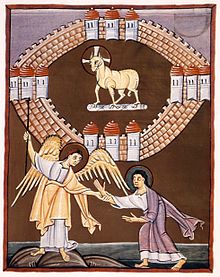At the end of the Revelation, John sees a new heavens and a new earth with a New Jerusalem as its principal city. The fate of the old Jerusalem has been described in the previous chapters. The first Jerusalem became Sodom and Egypt (Rev 11.8), and like Sodom and Egypt fell under the wrath of God. But out of the rubble of the old Jerusalem, God is making a new city. This new city is described in Revelation 21–22.
I have heard many a sermon at funerals as well as other venues that seek to comfort mourning Christians with this vision. It will be taught that John’s vision is that of our final resting place in heaven. While we can be comforted with many promises from John’s vision, this vision is not of heaven. This city that John sees is distinct from heaven because it comes down “out of heaven” (Rev 21.2). The New Jerusalem is also as much a people as it is a place. John sees the New Jerusalem as a “bride adorned for her husband” (Rev 21.2). Later, when the angel takes John to see the bride, the Lamb’s wife, he shows him a detailed vision of this holy city, the New Jerusalem (Rev 21.9-10). This vision is not of heaven, but it is of a heavenly city. That heavenly city is the church, the bride of Christ.
Paul uses the same imagery as John in his letters when describing the church. In Galatians 4.21ff. he speaks of those in Christ as children of the Jerusalem that is “from above.” In Ephesians 5 Paul speaks about the church as being the bride/wife of Christ. In fact, Paul spoke to the Corinthian church about how he betrothed them to Christ and that his aim was to present the church as a pure virgin (2Cor 11.2).
What John sees is the church as she is in Christ in the present and what she is becoming in Christ, a reality that waits to be seen. Like a child whose genetic make-up is encoded from birth so that his physical body grows up into what he already is, so the church has this genetic code in Christ Jesus so that we are growing up into what we already are. We haven’t reached our full maturity, but we are growing.
But into what are we growing? John sees a “New Jerusalem.” That is who we are. There are a number of characteristics of this city often mentioned in Scripture that inform us as to what it means to be the New Jerusalem. But the name of the city itself gives us God’s intention for us. There is some question as to whether Jerusalem means “possession of peace” or “foundation of peace,” but there is no question that “peace” is a part of the city’s name. Peace is God’s intention for the city, and it is the Prince of Peace that governs it.
Among all the other characteristics of the holy city, the church, we are to be characterized by peace. Peace is not merely the cessation of conflict or a cease fire. Even though there may be no outbursts of anger and/or violence, there may be tension and turbulence beneath the surface. God’s peace goes beneath the surface to the heart, creating love and joy in relationships. Bitterness is replaced by compassion. Communion replaces strife. Forgiveness covers sins. Deferential service to others replaces selfish ambition. Mercy overcomes vengeance. Suspicion gives way to trust. The rancor of conflict is conquered by the joy of fellowship. This is the peace that God intends for his city of peace. This is who we are. This is who we are to become. Be at peace.















